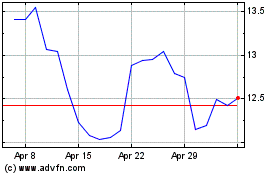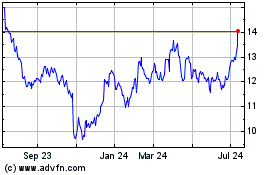U.S. Industrial Production Unexpectedly Declined in May -Update
June 15 2018 - 12:19PM
Dow Jones News
By Paul Kiernan
WASHINGTON -- U.S. industrial production ended three straight
months of growth in May with an unexpected decline due in part to a
fire at a major Ford Motor Co. supplier.
Industrial output, a measure of everything produced by the
nation's factories, mines and utilities, slipped 0.1% in May from
April in seasonally adjusted terms, the Federal Reserve said
Friday. Economists surveyed by The Wall Street Journal had forecast
a 0.2% increase.
The decline was led by a 0.7% fall in manufacturing output,
"largely because truck assemblies were disrupted by a major fire at
a parts supplier," the Fed said. Production of autos and light
trucks fell to a seasonally adjusted annual rate of 10.18 million
units in May from 11.28 million units in April.
The fire, which occurred May 2 at a parts plant in Michigan
operated by a unit of China's Wanfeng Auto Holding Group, led Ford
to idle production of flagship F-150 and Super Duty trucks for more
than a week. Output has since resumed.
Economists brushed aside the weaker-than-expected result, noting
that seasonal adjustments can be imperfect and survey-based
measures of manufacturing conditions have continued to indicate
improvement. Excluding motor vehicles and parts, U.S. manufacturing
output declined by a more modest 0.2% from April.
"The May drop is nothing to be concerned over," said Stephen
Stanley, chief economist at Amherst Pierpont Securities, in a note
to clients.
Manufacturing aside, U.S. industry continued to ramp up last
month, underpinning an economy that many experts say is on track to
post its fastest second-quarter growth in years. Consumers and
businesses alike ratcheted up spending in April on the back of
fiscal stimulus passed earlier this year and loose monetary
policy.
Mining output rose 1.8% in May, the fourth straight month of
gains, as oil and gas drilling rose to meet a jump in prices
earlier this year.
Utilities production likewise rose 1.1% on sharply higher
electricity generation. Last month was the warmest May on record,
according to the National Oceanic and Atmospheric Administration,
with above-average temperatures in all 48 contiguous states. That
likely lifted electricity demand as consumers turned up the air
conditioning.
Capacity utilization, a measure of industrial slack that
measures production relative to industries' potential, declined by
0.2 percentage point last month from April to 77.9%. Economists had
expected capacity utilization to be 78.1%.
Compared with May 2017, overall industrial production was up
3.5%.
"Looking at these data on a smoothed basis provides a picture
consistent with all the other evidence depicting a stronger
manufacturing sector," said Joshua Shapiro, chief U.S. economist at
MFR, Inc., in a note to clients.
Write to Paul Kiernan at paul.kiernan@wsj.com
(END) Dow Jones Newswires
June 15, 2018 12:04 ET (16:04 GMT)
Copyright (c) 2018 Dow Jones & Company, Inc.
Ford Motor (NYSE:F)
Historical Stock Chart
From Mar 2024 to Apr 2024

Ford Motor (NYSE:F)
Historical Stock Chart
From Apr 2023 to Apr 2024
